This Month's Articles
REVIEWING
A Replacement Life
By Boris Fishman
Reviewed by Jan Alexander

The Writer as Thief
This is what Slava Gelman, the young psychological warrior of A Replacement Life is up against: “I was told they had seen a bottle of blood on the Jew’s table,” says the conniving mother of a slain boy, pointing at Yakov Bok, a Jew who has been living under false pretexts in Kiev circa 1911.
“The Jew killed my child....”
The mother and her lover killed the boy, actually, but the entire village is happy to send a Jew to the gallows. The villagers believe that Jews bake their matzos with the blood of Christian children.
The scene is not from Boris Fishman’s illuminating debut novel, but from Bernard Malamud’s 1966 novel, The Fixer.
Fishman has said that while writing the novel he read Malamud every day. And at the end of his novel he presents a note acknowledging all of the writers whose words or thoughts he borrowed.
“Life is sin and art is theft,” he writes
Most novelists call this kind of theft “inspiration,” but it’s a fitting tribute in a novel that,....Read More
REVIEWING
Art for Equality: The NAACP’s Cultural Campaign for Civil Rights
By Jenny Woodley
Reviewed by Fred Beauford

Changing hearts and mind through art
When I accepted the job as only the sixth editor of the Crisis magazine, the official publication of the NAACP, the magazine founded in 1910 by W.E.B. Du Bois, the only real direction I received from the CEO of the organization, Benjamin L. Hooks, and the man who recruited me, was “see if you can get more of the arts in there.”
At that time, at the very end of 1984, coverage of the arts had long been absence from the magazine, as much as everything else. But that was not always the case. Once in its long history, the Crisis was highly praised, and quickly became one of the most influential and respected publications in America because of political fearlessness, its understanding of the written laws of this country and the unwavering willingness to fight for the equal rights of blacks; and, interestingly enough, for its coverage of the arts.
In fact, the arts quickly became a central focus of the NAACP, founded in 1909 by white liberals, one....Read More
REVIEWING
The Hen Who Dreamed She Could Fly
By Sun-mi Hwang, translated by Chi-Young Kim
Reviewed by Sally Cobau
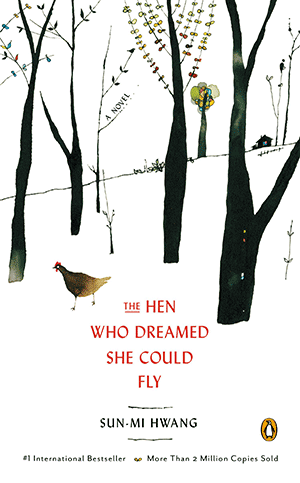
I Dare You To Read This Book Without Crying
The Hen Who Dreamed She Could Fly is a delightful story written by South Korean author Sun-mi Hwang. The story is part fairy-tale, part pastoral, part allegory, and focuses on the ingenuity of a plucky hen named Sprout. In essence what happens is after Sprout makes a move to change her life, a series of adventures unfold—friendships are made and hearts broken, and Sprout acts in a way that is extremely brave.
But back to the beginning. Bred to produce eggs for a poor South Korean farmer, Sprout becomes depressed with the realization that her egg laying is for naught—she will never hatch a baby chick.
Faced with this epiphany, she realizes that she has a choice—to give up all hope and die or try to accomplish the one thing she wants in life—to have a baby.
Don’t let the simplicity of the story fool you. Sprout’s dilemma is existential. By focusing on a scraggly hen, Hwang asks serious questions such as What does it ....Read More
REVIEWING
The Sixth Extinction—an Unnatural History
By Elizabeth Kolbert
Reviewed by Jane M McCabe
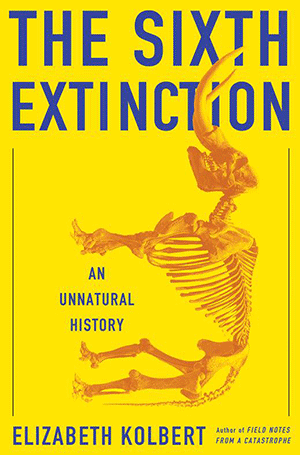
We Have Been Warned
Elizabeth Kolbert is a foremost writer on catastrophic happenings, such as global warming and its consequences (see Field Notes for a Catastrophe, published in 2008.) She is a staff writer for The New Yorker, an observer and commentator on environmentalism. Field Notes attempts to bring attention to the causes and effects of global climate change. To write it Ms. Kolbert traveled around the world where the effects from climate change are the most evident—to Alaska, Greenland, The Netherlands and to Iceland. The effects consists of rising sea levels, thawing permafrost, diminishing ice shelves, changes in migratory patterns and increasing forest fires due to the loss of precipitation.
She writes about America’s reluctance to reduce our carbon emissions, the primary culprit that is causing global warming. And yet, with all the evidence at hand, there are those who deny what is happening to our planet and assign it to “business as usual” on planet earth!
And now with the publication of....Read More
POEM
JACKSON COUNTY, MISSISSIPPI
A Poem by Alice Anderson
She has a warrant out for her arrest.
The silvery points
of steel badges
all point in her
direction – spears
of light, of grace, of
terror.
Her....Read More
REVIEWING
This Nonviolent Stuff’ll Get You Killed—How Guns Made the Civil Rights Movement Possible
By Charles E. Cobb, Jr
Reviewed by Herb Boyd
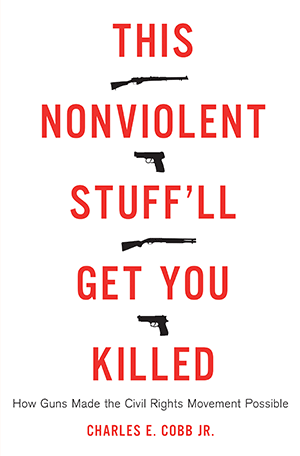
In the world of publishing, as in many other walks of life, timing is everything. Whether it was intended or just happened to arrive on 50th anniversary of the signing of the Civil Rights Act in 1964, Charles E. Cobb, Jr. will not quibble about the publication of his book This Nonviolent Stuff’ll Get You Killed—How Guns Made the Civil Rights Movement Possible. Even before you open the first page, the mere fact that this is an effort by one of the movement’s most endearing members, one of unimpeachable integrity, is enough to command at least a cursory glance.
That cursory glance quickly becomes a lengthy read as Cobb transport you across a history of encounters where guns, both real and imagined are at the foci of his absolutely absorbing narrative. “This is not a book about black guerrilla warfare, retaliatory violence, or ‘revolutionary’ armed struggle, and I make no attempt to argue such actions were either necessary or possible,” he explains in the introduction.
“Nor is this a book about nonviolence. Rather, it is about people—especially young people—who participated in a nonviolent movement without having much commitment to nonviolence beyond agreeing to use it as a tactic.”
Cobb addresses this history with authority since as a field secretary for the Student Nonviolent Coordinating....Read More
MEMOIR
THE PUBLIC SPECTACLE
A FICTIONAL REMEMBRANCE
By Robert Macbeth
NEUROSIS
A functional disorder of the central nervous system
marked by anxiety, phobias, obsessions, or compulsions.
Individual or group behavior that is characterized by rigid adherence to an idealized concept of the personal or social organism, especially when that concept is at variance with reality and results in interpersonal, cultural, or political conflict and the development of discomforting intra-organismal tensions.
CHRONIC
Marked by long duration, by frequent recurrence, and often by progressing seriousness.
AN INTRODUCTION
I have prefaced this writing with a formal definition of words that infer the inner tendencies of what is to follow. I do this so that readers who like myself prefer not to get involved in the confessions of confused Negroes can move on to some more pleasant literary entertainment. But for those who might be interested in the workings of a very creative, perhaps genius artist mind, ....Read More
PORTFOLIO
Portfolio:
by Steve Fisch
Linda Kunik
THAT 'AH HA' FACTOR

Linda Kunik’s photographs hold nothing back. They are raw, sensuous and exciting, exploding with vibrant color.
Waiting for the right moment, when nature’s sun and the subjects’ skin line up perfectly, takes patience -- lots of patience. And when it’s all in alignment, when every curve is perfect, Linda ever so slowly pushes on the shutter release of her DSLR, so as not to disturb the scene she has cultivated.
And to think the subject matter I’m writing about here are photographs of tomatoes grown in Linda Kunik’s own backyard. But more about this later.
It’s interesting to note that photography was not something Linda focused on when she was growing up in Illinois. Born in Chicago, the family moved to the country near Bloomingdale when she was five. With five siblings, there were lots of mouths for her parents to feed. Linda helped out in the garden. It was while working in the family garden her love of nature bloomed and became a part of her. But more about. ....Read More
REVIEWING
Harlem’s Rattlers and the Great War: The Undaunted 369th Regiment and the African American Quest for Equality
By Jeffrey T. Sammons and John H. Morrow, Jr.
Reviewed by Brenda M. Greene
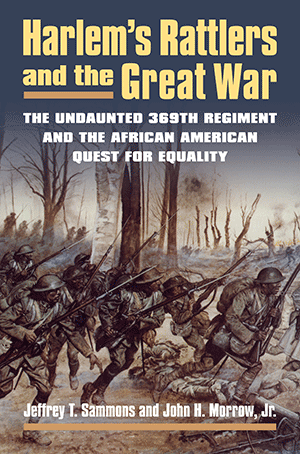
Harlem Goes to War
This comprehensive and in-depth study, with photos, extensive notes and biographical references was written over a ten-year period. It provides the reader with an additional lens by which to view the legacy of Harlem’s Rattlers. It is a book that readers of military history will cherish and that general readers and lovers of history will find informative. It is both a reference book and an important historical narrative that lays the ground for the civil rights movement.
At a recent forum on Harlem’s Rattlers and the Great War at Medgar Evers College, Sammons began his presentation by describing how the story of the Black soldiers who served in this unit was a testimony to the character of these men:
He told the audience “that it is character, not reputation that determines your place in history and the legacy which you will leave. If these men had been dependent on the reputation by which they were labeled, they would have never formed the unit that marked them in history. Their character speaks loudly in this important study of the “Undaunted 369th Regiment.”
The rattler, distinguished by....Read More
REVIEWING
F. Scott Fitzgerald’s Fiction:
“An Almost Theatrical Innocence”
By John T. Irwin
Reviewed by M. J. Moore
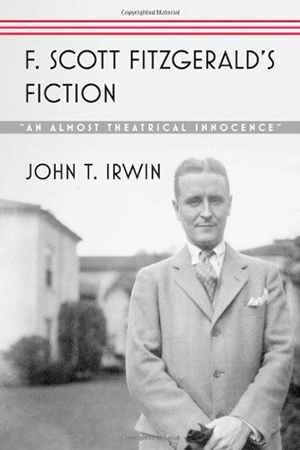
Is another book about the author of The Great Gatsby really necessary?
Well, yes. We do need this new and highly personalized account of the fiction of F. Scott Fitzgerald.
This is a luminous, eye-opening, deeply appreciative study about the writings of Fitzgerald, as opposed to yet another chronicle of his high life and hard times; his roller-coaster of a marriage to Zelda; and his foray into Hollywood, the struggles with booze and depression, and his whole latter-day life framed as a cautionary tale.
Indeed, this is precisely the kind of book that’s long overdue: A comprehensive overview of the fiction Fitzgerald created—the seemingly innumerable short stories, and his novels. This book is anchored by the author’s profound love for the literary achievements of a writer who is too often pigeonholed only as the guy who wrote The Great Gatsby. That classic was one of many distinguished offerings.
Perhaps the greatest offering of all is the gift that a major author like Fitzgerald leaves to generations of readers. That is, the gift of transporting others’ minds and ....Read More
REVIEWING
Under Fire
By Fred Burton and Samuel M. Katz
Read by: Jeff Gurner
Macmillan Audio | 2013 | Running time: 10 hours | 8 CDs | $39.99
Reviewed by Michael Carey
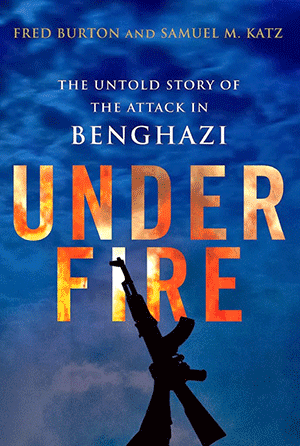
If you are like me, you have a hard time keeping up with the news, and like me, you’ll say it’s because of the 24hr news system that promotes pointless and often ignorant commentary with obviously biased, agenda-driven dialogue. Having said that, the news is important, and I’m embarrassed to say how little I knew of the attack on the diplomatic mission in Benghazi in 2012.
I heard about it, but it seems like even before the survivors were back on US soil, the news was looking to point fingers and shouting about conspiracies. I wanted to know what happened and what it meant for our country, but I tuned out the mainstream media. This personal confession leads us to Under Fire. If you want to know in an in-depth, play-by-play account of what transpired that September 11th in 2012, Under Fire is the audio book for you.
Starting with the authors, Under Fire is detailed and informed. Fred Burton is a former Department of State agent (like the ones in the mission fighting to protect the Ambassador, Christopher Stevens, and the Information Officer, Sean Smith) and now vice president of Intelligence and Counterterrorism at Stratfor. He is an expert on security and ....Read More
ESSAY
At Play in the Fields of BOOK WORLD
An essay by M. J. Moore
Book World was neither a skimpy nor a minor publication. Edited out of Byron Dobell’s office at the New York Herald Tribune in Manhattan, the Sunday periodical devoted entirely to reviews of new books, literary columns, and authors’ interviews was a substantial, much-admired weekly compendium of opinions. It appeared as a Sunday supplement in the Washington Post and the Chicago Tribune, as well as in the New York Herald Tribune. Its circulation was in the millions.
On Sunday, October 29, 1967, the first review that Mario Puzo ever wrote for editor Byron Dobell was published. Not only did Puzo think that Dobell “was the only guy that would have printed it,” but also that “certainly [he was] the only editor who would have given it a front page.”
The piece was written as a critique of Writers at Work: The Paris Review Interviews. This was the third volume of collected interviews culled from the literary quarterly that had been co-founded in Paris in 1953 by short-term expatriates George Plimpton, William Styron, Peter Matthiessen, Harold “Doc” Humes and others
The Paris Review had morphed into a remarkably consistent, esteemed literary quarterly with an emphasis on publishing new short stories and poems by writers who were then gradually building careers. The new poems and stories in each issue were placed before and after what soon became the ....Read More
